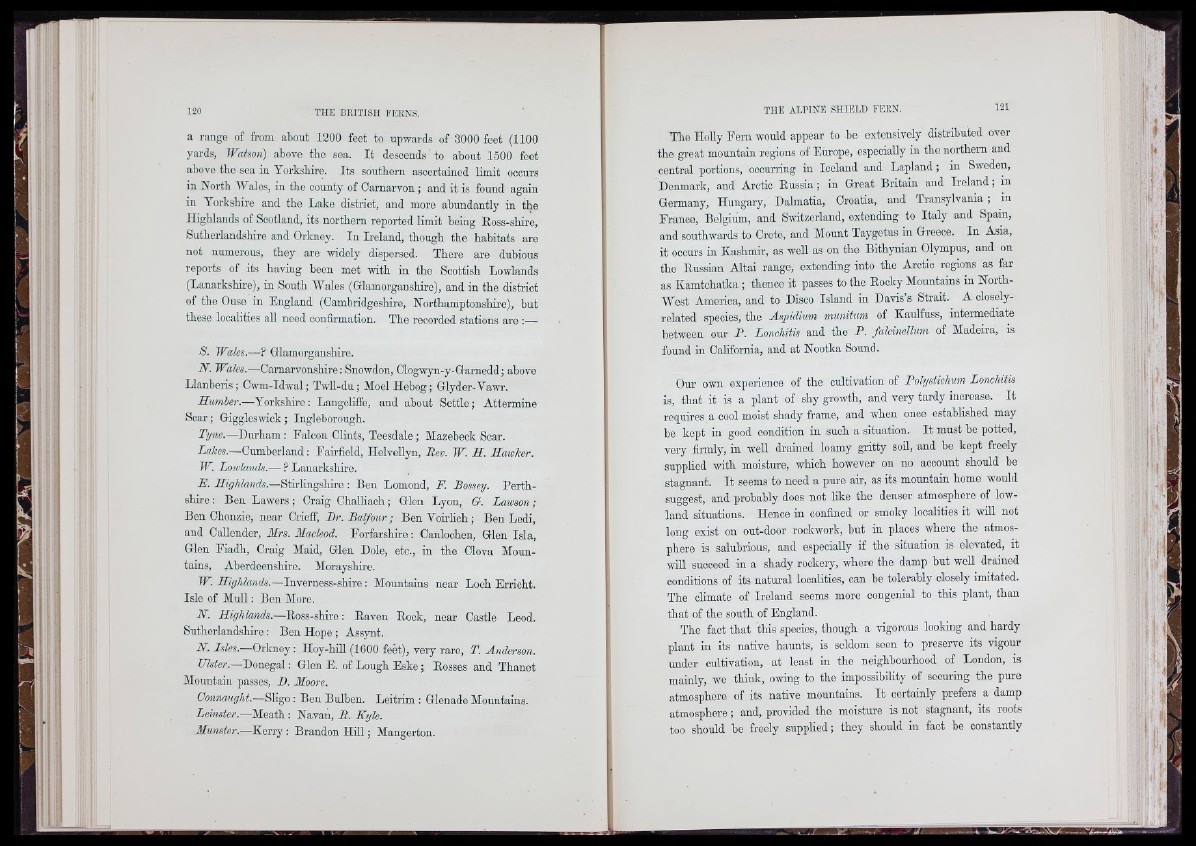
a range of from about 1 2 0 0 feet to upwards of 3000 feet ( 1 1 0 0
yards, Watson) above tbo sea. I t descends to about 1500 feet
above tlie sea in Yorksliire. Its soutbeni ascertained limit ooours
in North lYales, in the county of Carnarvon ; and it is found again
in Yorkshire and the Lake district, and more abundantly in the
Ilighlands of Scotland, its northern reported limit being Ross-shire,
Sutherlandshire and Orkney. In Ireland, though the habitats are
not numerous, they are widely dispersed. There are dubious
reports of its having been met with in the Scottish Lowlands
(Lanarkshire), in South Wales (Glamorganshire), and in the district
of the Ouse iu England (Cambridgeshire, Northamptonshire), but
these localities all need confirmation. The recorded stations are :—
S. Wales.—? Glamorganshire.
N. Wales.—Carnarvonshire; Snowdon, Clogwyn-y-Garnedd; above
Llanheris; Cwm-Idwal; Twll-du; Moel Ilebog; Glyder-Yawi'.
Humber.—Yorkshire; Langcliffe, and about Settle; Attermine
Soar; Giggleswick ; Ingleborough.
Tyne.—Durham; Falcon Clints, Teesdale ; Mazebeck Soar.
Lakes.—Cumberland; Fairfield, Helvellyn, Rev. W. H. Hawker.
W. Lowlands.— ? Lanarkshire.
E. iKy/i/aiiifs.—Stirlingshire ; Ben Lomond, F. Bossey. Perthshire
; Ben Lawers; Craig Challiaeh; Glen Lyon, G. Lawson;
Ben Chonzie, near Crieff, Dr. Balfour; Ben Voirlich; Ben Ledi,
and Callender, Mrs. Macleod. Forfarshire: Canloohen, Glen Isla,
Glen Fiadh, Craig Maid, Glen Dole, etc., in the Clova Mountains,
Aberdeenshire. Morayshire.
W. Highlands.—Inverness-shire: Mountains near Looh Erricht.
Isle of M u ll; Ben More.
N . Highlands.—Ross-shire; Raven Rock, near Castle Leod.
Sutherlandshire; Ben Hope ; Assynt.
N . Isles.—Orkney; Hoy-hill (1600 feet), very rare, T. Anderson.
Ulster.—Donegal; Glen E. of Lough E sk e ; Rosses and Thanet
Mountain passes, B. Moore.
Connaught.—Sligo; Ben Bulben. Leitrim ; Glenade Mountains.
Leinster.—Meath ; Navan, R. Kyle.
Munster.— Kcirry; Brandon H ill; Mangerton.
The Holly Fern would appear to be extensively distributed over
the great mountain regions of Europe, especially in the northern and
central portions, occurring in Iceland and Lapland ; in Sweden,
Denmark, and Arctic Russia ; in Great Britain and Ire lan d ; in
Germany, Hungary, Dalmatia, Croatia, and Transylvania ; in
France, Belgium, and Switzerland, extending to Italy and Spam,
and southwards to Crete, and Mount Taygetus in Greece. In Asia,
it occurs in Kashmir, as well as on the Bithynian Olympus, and on
the Russian Altai range, extending into the Arctic regions as far
as Kamtchatka ; thence it passes to the Rocky Mountains in North-
West America, and to Disco Island in Davis’s Strait. A closely-
related species, the Aspidium munitum of Kaulfuss, intermediate
between our B. Lonchitis and the P . falckicllum of Madeira, is
found in California, and at Nootka Sound.
Our own experience of the cultivation of Polystichum Lonchitis
is, th a t it is a plant of shy growth, and very tardy increase. I t
requires a cool moist shady frame, and when once established may
be kept in good condition in such a situation. I t must be potted,
very firmly, in well drained loamy gritty soil, and be kept freely
supplied with moisture, which however on no account should be
stagnant. I t seems to need a pure air, as its mountain home would
suggest, and probably does not like the denser atmosphere of lowland
situations. Hence in confined or smoky localities it will not
long exist on out-door rookwork, hut in places where the atmosphere
is salubrious, and especially if the situation is elevated, it
will succeed in a shady rookery, where the damp but well drained
conditions of its natural localities, can he tolerably closely imitated.
The climate of Ireland seems more congenial to this plant, than
th a t of the south of England.
The fact that this species, though a vigorous looking and hardy
plant in its native haunts, is seldom seen to preserve its vigour
under cultivation, at least in the neighbourhood of London, is
mainly, we think, owing to the impossibility of securing the pure
atmosphere of its native mountains. I t certainly prefers a damp
atmosphere ; and, provided the moisture is not stagnant, its roots
too should be freely supplied; they should in fact be constantly